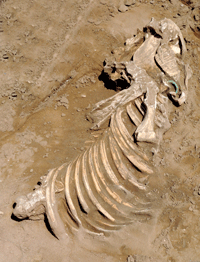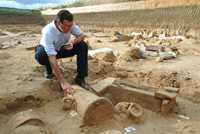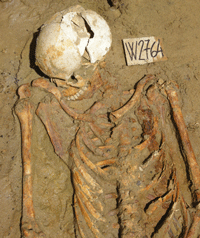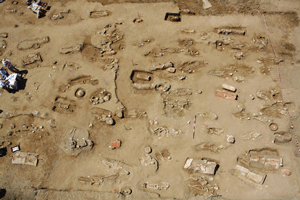
Rewriting one of the ancient world's most dramatic battlefield accounts

Archaeologists uncovered the remains of dozens of soldiers who fought in the Battle of Himera. Evidence for mass burials of war dead is extremely rare in the ancient Greek world. (Courtesy Soprintendenza Archeologica di Palermo)
It was one of the ancient world's greatest battles, pitting a Carthaginian army commanded by the general Hamilcar against a Greek alliance for control of the island of Sicily. After a fierce struggle in 480 B.C. on a coastal plain outside the Sicilian city of Himera, with heavy losses on both sides, the Greeks eventually won the day. As the years passed, the Battle of Himera assumed legendary proportions. Some Greeks would even claim it had occurred on the same day as one of the famous battles of Thermopylae and Salamis, crucial contests that led to the defeat of the Persian invasion of Greece, also in 480 B.C., and two of the most celebrated events in Greek history.
Nonetheless, for such a momentous battle, Himera has long been something of a mystery. The ancient accounts of the battle, by the fifth-century B.C. historian Herodotus and the first-century B.C. historian Diodorus Siculus ("the Sicilian"), are biased, confusing, and incomplete. Archaeology, however, is beginning to change things. For the past decade, Stefano Vassallo of the Archaeological Superintendency of Palermo has been working at the site of ancient Himera. His discoveries have helped pinpoint the battle's precise location, clarified the ancient historians' accounts, and unearth new evidence of how classical Greek soldiers fought and died.

Buried near the soldiers were the remains of 18 horses that likely died during the battle, including this one that still has a bronze ring from its harness in its mouth. (Pasquale Sorrentino)


Archaeologist Stefano Vassallo has been excavating the site of ancient Himera for many years. This soldier's remains were found with a spearblade still embedded in his left side. (Courtesy Soprintendenza Archeologica di Palermo; Pasquale Sorrentino)
Beginning in the middle of the eighth century B.C., when the Greeks founded their first colonies on the island and the Carthaginians arrived from North Africa to establish their presence there, Sicily was a prize that both Greeks and Carthaginians coveted. The Greek city of Himera, founded around 648 B.C., was a key point in this rivalry. Himera commanded the sea-lanes along the north coast of Sicily as well as a major land route leading south across the island. In the first decades of the fifth century B.C., the competition to dominate Sicily intensified. Gelon of Syracuse and Theron of Akragas, both rulers of Greek cities on the island, formed an alliance not only to counter the power of Carthage, but also to gain control of Himera from their fellow Greeks. They soon achieved their goal and exiled the city's Greek ruler, who then appealed to Carthage for help. Seeing an opportunity to seize the upper hand in the struggle for Sicily, the Carthaginian leader Hamilcar mobilized his forces. The stage was set for the battle of Himera.
The fullest account of what happened next comes from Diodorus Siculus. The historian claims that Hamilcar sailed from Carthage with a huge army of some 300,000 troops, but a more realistic figure is probably around 20,000. Along the way, Hamilcar's fleet ran into a storm that sank the transports carrying his horses and chariots. Undeterred, the general set up a fortified seaside camp on the shore west of Himera to protect his remaining ships and built walls to block the western land approaches to the city. The outnumbered Greek defenders sallied out from the city to protect Himera's territory, only to lose the first skirmishes.
Before Vassallo began his excavations, scholars had been unable to pinpoint the location of these clashes. In 2007, however, he uncovered the northwestern corner of the city's fortification wall. He also found evidence that the coastline had shifted since ancient times, as silt carried from the streams above Himera broadened the plain. These two discoveries clarify Diodorus' account. The fighting must have occurred in the coastal plain between the wall and the ancient shoreline, which in the fifth century B.C. was closer to the city than it is today.
Although the Greeks received reinforcements, they were still outnumbered. In the end, they got lucky. According to Diodorus, scouts from Gelon's camp intercepted a letter to Hamilcar from allies who promised to send cavalry to replace the losses he had suffered at sea. Gelon ordered some of his own cavalry to impersonate Hamilcar's arriving allies. They would bluff their way into Hamilcar's seaside camp and then wreak havoc. The ruse worked. At sunrise the disguised Greek cavalry rode up to the Carthaginian camp, where unsuspecting sentries let them in. Galloping across the camp, Gelon's horsemen killed Hamilcar (although the historian Herodotus says Hamilcar killed himself) and set fire to the ships drawn up on the beach. At that signal, Gelon advanced from Himera to meet the Carthaginians in pitched battle.
Scholars have long questioned Diodorus' description of these events, but in 2008 Vassallo's team began to excavate part of Himera's western necropolis, just outside the city wall, in preparation for a new rail line connecting Palermo and Messina. The excavations revealed 18 very rare horse burials dating to the early fifth century B.C. These burials remind us of Diodorus' account of the cavalry stratagem the Greeks used against Hamilcar. Were these perhaps the mounts of the horsemen who bluffed their way into the Carthaginian camp?
At first the Carthaginian troops fought hard, but as news of Hamilcar's death spread, they lost heart. Many were cut down as they fled, while others found refuge in a nearby stronghold only to surrender due to lack of water. Diodorus claims 150,000 Carthaginians were killed, although the historian almost certainly exaggerated this number to make the Greek victory more impressive. The Carthaginians soon sought peace. In addition to surrendering their claim to Himera, they paid reparations of 2,000 talents, enough money to support an army of 10,000 men for three years. They also agreed to build two temples, one of which may be the Temple of Victory still visible at Himera today.
In the summer of 2009, Vassallo and his team continued excavating in Himera's western necropolis. By the end of the field season, they had uncovered more than 2,000 graves dating from the mid-sixth to the late fifth centuries B.C. What most attracted Vassallo's attention were seven communal graves, dating to the early fifth century B.C., containing at least 65 skeletons in total. The dead, who were interred in a respectful and orderly manner, were all males over the age of 18.

In addition to the soldiers' graves, Vassallo's team has uncovered more than 2,000 burials dating from the sixth to fifth century B.C. in Himera's massive necropolis. (Courtesy Soprintendenza Archeologica di Palermo)
At first Vassallo thought he might have found victims of an epidemic, but seeing that the bodies were all male and that many displayed signs of violent trauma convinced him otherwise. Given the date of the graves, Vassallo realized that these could be the remains of men killed in the battle of 480 B.C., which would be highly significant for reconstructing the Battle of Himera. Their placement in the western necropolis strongly suggests that the main clash between the Greek and Carthaginian armies took place near the western walls of the city. Since bodies are heavy to move, it's likely they were buried in the cemetery closest to the battlefield, especially if there were many dead to dispose of. (In contrast, Himera's eastern necropolis on the far side of the city, which Vassallo had previously excavated, contains no communal graves.) Vassallo also has a hypothesis about the soldiers' origins. They were probably not Carthaginians, for the defeated enemy would have received little respect. Dead Himeran soldiers would likely have been collected by their families for burial. Instead, Vassallo believes many or all of the dead were allied Greeks from Syracuse or Akragas. These warriors, who died far from home, could not be taken back to their native soil for burial. Instead, they were honored in Himera's cemetery for their role in defending the city.
The bones of Himera have more stories to tell. For all that has been written about Greek warfare by poets and historians from Homer to Herodotus and Diodorus, ancient literature tends to focus on generals and rulers rather than on how ordinary soldiers fought and died. Until Vassallo's excavations, only a handful of mass graves from Greek battles—such as those at Chaeronea, where Philip of Macedon defeated the Greeks in 338 B.C.—had been found. These graves were explored before the development of modern archaeological and forensic techniques.

Scholars analyzing the bones from Himera's soldiers hope to learn more about Greek warfare, such as the extent of stress injuries caused by carrying heavy bronze-covered shields, as depicted on this black-figure vase found at the site. (Pasquale Sorrentino)
In contrast, Vassallo's team worked with an on-site group of anthropologists, architects, and conservators to document, process, and study their discoveries. Thanks to their careful methods, the Himera graves may represent the best archaeological source yet found for classical Greek warfare. Further analysis of Himera's battle dead promises to offer much about the soldiers' ages, health, and nutrition. It may even be possible to identify the men's military specialties by looking for bone abnormalities. Archers, for example, tend to develop asymmetrical bone growths on their right shoulder joints and left elbows. Hoplites, the armored spearmen who constituted the main infantry forces of Greek armies, carried large round shields weighing up to 14 pounds on their left arms. The burden of carrying such a shield may have left skeletal traces.
Studying Himera's dead is also revealing the gruesome realities of ancient warfare. Initial analysis shows that some men suffered impact trauma to their skulls, while the bones of others display evidence of sword cuts and arrow strikes. In several cases, soldiers were buried with iron spearheads lodged in their bodies. One man still carries the weapon that killed him stuck between his vertebrae. Analysis of the types and locations of these injuries may help determine whether the men fell in hand-to-hand combat or in an exchange of missiles, while advancing or in flight. The arrowheads and spearheads uncovered with the men can also provide other important evidence. Ancient soldiers typically employed the distinctive weapons of their home regions, so archaeologists may be able to discover who killed the men buried at Himera by studying the projectiles embedded in their remains.
Although they won the first battle of Himera, the Greeks would not have the upper hand forever. In 409 B.C. Hamilcar's grandson Hannibal returned to Himera, bent on revenge. After a desperate siege the city was sacked and destroyed forever. In the western necropolis, Vassallo has discovered another mass grave, dating to the late fifth century B.C., which contains 59 burials. He believes these may be the graves of the Himerans who fell protecting their city against this later Carthaginian assault.
Vassallo is careful to emphasize that more study of the skeletal remains, grave artifacts, and topography is required before definitive conclusions can be drawn. Nonetheless, it is already clear that his recent discoveries will be of major importance for understanding the history of ancient Himera, the decisive battles that took place there, and the lives and deaths of the ordinary Greek soldiers who fought to defend the city.
John W. I. Lee is a professor of history at the University of California at Santa Barbara. His research specialty is classical Greek warfare.
Advertisement

Advertisement







